

20 CENTS IF YOU TAKE THIS BOOKLET HOME
TONTO NATIONAL MONUMENT
ARIZONA
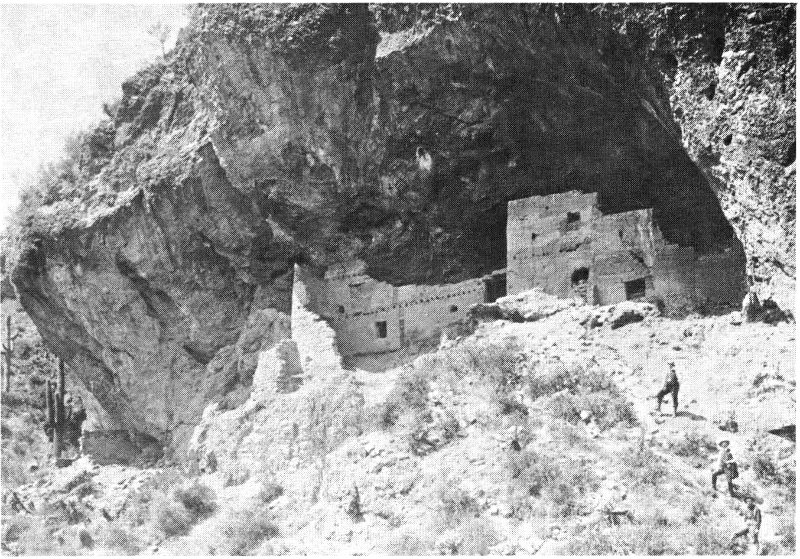
The Lower Ruin in 1910
Lubken photo, courtesy H. B. Clark
Although Tonto National Monument was established in 1907 it received little protection until 1930. Considerable vandalism and thoughtless destruction of much of the prehistoric material took place in the 1920s.
In recent years some prehistoric Indian ruins have had to be closed to visitors to preserve these fragile structures. Please help us keep the Lower Ruin open for many years to come: restrain children from climbing and running in the dwelling, and keep off the walls.
Along the trail and in the ruin are numbered stakes indicating features of interest. Corresponding numbered paragraphs in this booklet describe them.
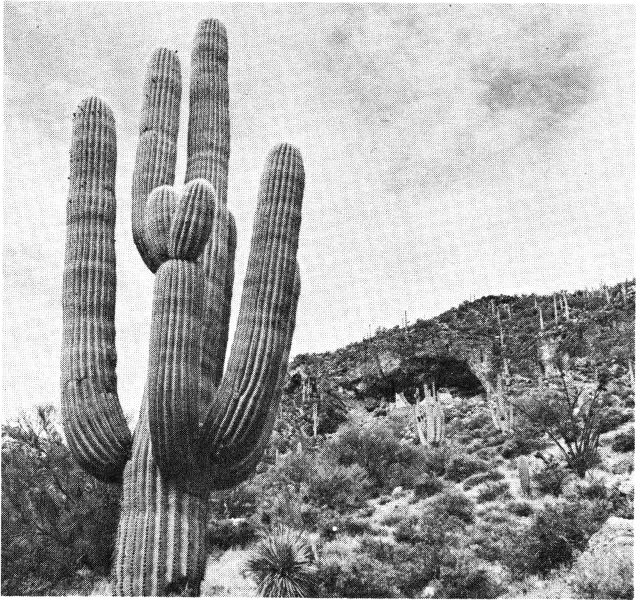
Typical Desert Landscape and the Lower Ruin
Brutal heat in summer, hard frosts in winter, strong shrivelling winds of spring, and always erratic rainfall combine here to make a desert, a place of extremes. The world’s arid lands are of many kinds; here is the Upper Sonoran Desert, with its giant cactus and remarkably varied plant life. Here are found many creatures which have adapted in behavior or body features to arid conditions. Man too has evolved in the desert in many ways, over at least ten thousand years, from roving bands of primitive hunters to the massive urban developments of today.
Nearly seven hundred years ago farming Indians now called the Salado (sa-LAH-doe) fitted their lives to this desert. They lived in cool, thick-walled apartment-like villages, grew irrigated crops of corn, squash, beans, cotton and amaranth (pigweed), made handsome pottery and wove elaborate cotton textiles. Though capable farmers, the Salado were also hunters and gatherers, well aware of the uses 2 to be made of the desert’s wild resources.
As you walk the winding half-mile trail to the Lower Ruin you will see many desert plants used by the Salado so long ago, some of the birds, and perhaps other wild creatures of the desert which are active during the day.
Take time to breathe the fragrant dry air of the desert, look about you, enjoy just being, listen to the silence. Don’t feel bound to reading this little book; this is simply a guide to some of what you will see. We hope that you will see—and feel—much more.
1 BABY SAGUARO. This little white-spined cactus, an infant less than ten years old now, will grow up in a hundred years or so to look like the towering giants scattered over these hills. Young saguaros (sah-WAR-ohs) are delicate and need a “nurse tree” like this mesquite to shelter them from the sun.
2 HEDGEHOG CACTUS. The first cactus to bloom each spring; the large magenta blossoms of this many-headed plant must have been a welcome sight to the Salado, for they signalled relief to come from the monotonous winter diet of dried foods.
3 BARREL CACTUS. Though the barrel cactus is fabled as a source of emergency water in the desert, it is not at all reliable. The amount of unpleasant-tasting liquid in it varies with the amount and recency of rainfall.
Not much use was made of the barrel cactus; its fruit is unpalatable, but several finger rings made of its hooked red spines were found in the cliff dwelling. Recent desert Indians sometimes made cooking pots of the barrel: they cut off its top and removed some of the pulp from the stump, then put food in the cavity and dropped in hot stones to cook it.
4 TESAJO (tess-AH-hoe). Tiny edible tomato-red fruits, ready in November and December, give this little member of the cholla (CHOY-ya) cactus group its other name: Christmas cactus.
5 YUCCA (YUH-ca). This very useful plant provides many things. Leaf fibers make strong thread for mats, string, rope, sandals, nets and snares; the buds, flowers, fruit, stalks and seeds are edible. The root contains saponin, useful as a medicine or as soap or an excellent shampoo. Sharp leaf tips make good awls.
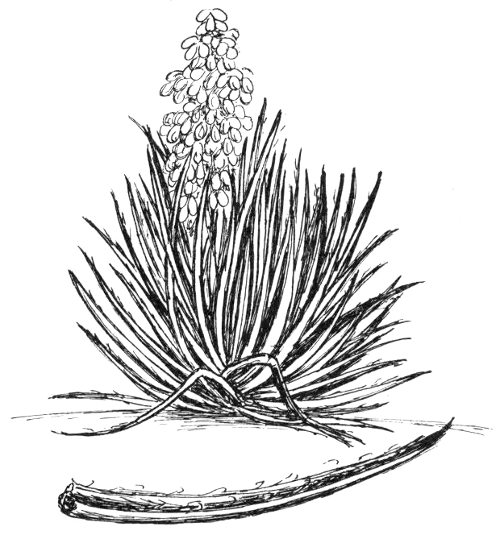
Yucca
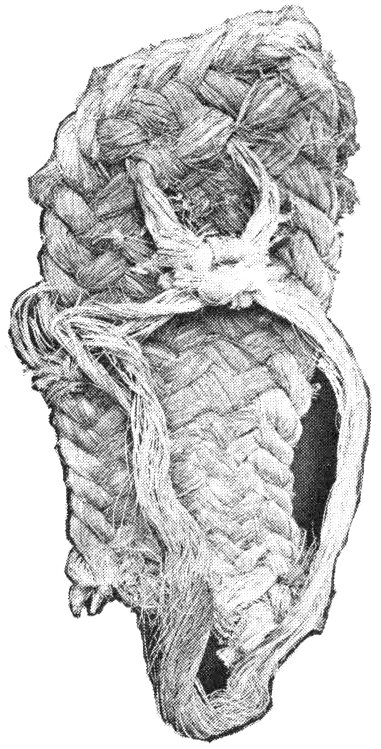
A prehistoric sandal woven of loosely spun yucca fiber.
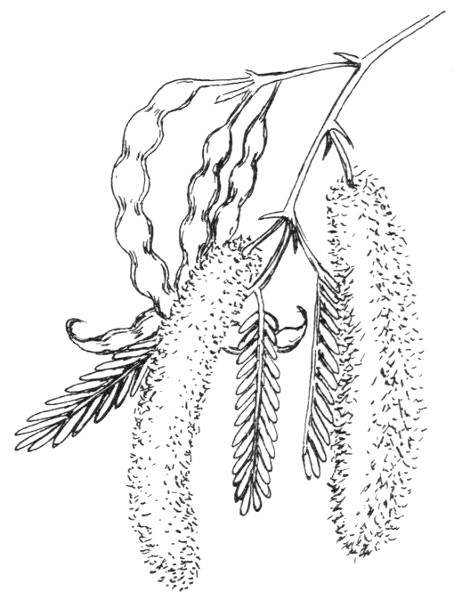
Mesquite leaves and beans
6 MESQUITE. Pods and beans of the mesquite (mes-KEET), nutritious and sweet, are still an important part of the desert Indian’s diet. Pods are ground into flour and pressed to make little loaves of staple bread. Fermented, the same flour makes an intoxicating drink. The sweet sap of the tree can be used to make candy, black dye, or even glue for broken pottery.
Mesquite has invaded vast areas during the past century, areas once desert grasslands. Cattle, grazing this land since the 4 1870s, have eaten away the grasses, encouraging growth of woody species like mesquite. The sweet mesquite pods are a favorite cattle food, and the beans pass unharmed through the digestive tract to be deposited far and wide. A natural cycle of drought and erosion coupled with heavy grazing has destroyed much of the desert grassland and converted it to mesquite. With loss of the grasses, erosion has accelerated, springs have dried up, and formerly sandy and smooth canyon floors (once suitable for small-scale farming) have eroded to boulder-strewn wastes. In less than a century we have made drastic changes in the desert, changes whose consequences we are only beginning to see.
7 SOTOL. Mats, sandals, coarse ropes and other household items can be made of the fibers in the narrow leaves of this plant. Young flower stalks of sotol (SO-tall) are edible when roasted; many deep stone-lined roasting pits are found throughout this area.
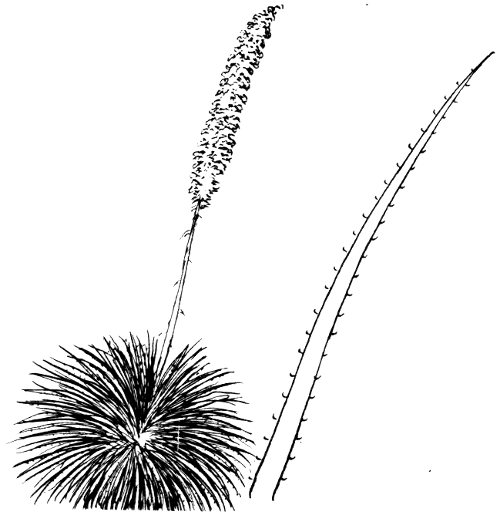
Sotol leaf and fruiting stem.
8 LICHENS (LIE-kens). The green and orange blotches resembling paint on this boulder are lichens, plants consisting of an alga and a fungus living together. As the plants grow, their secretions begin dissolving solid rock into fragments, the first step in the long natural process of soil formation. It has been estimated that in the desert it takes 1,000 years to develop one inch of topsoil.
9 OCOTILLO (oh-ko-TEE-yo). This thorny member of the candlewood family (NOT a cactus!) has handsome orange-red flowers at the ends of each branch in spring. Orioles[1], hummingbirds and bumblebees love ocotillo nectar. Like the palo verde, the ocotillo drops its leaves to conserve moisture while its green bark carries on a minimum of food manufacture. Within a few days of a good rain it sprouts a whole new set of leaves, only to shed them again as soon as the soil dries. The plant may develop and shed a half dozen sets of leaves in a single growing season.
10 SAGUARO SKELETON. The Salado built roofs and fashioned tools from the wooden ribs of saguaro skeletons, such as those in various states of decomposition up the draw above you. Skeletons also supplied wood for household fires in an area with few other fuel sources.
11 CANE CHOLLA. Flower buds of many types of cholla are edible; Pima Indians, modern desert farmers living near Phoenix, steam them as vegetables. The curve-bill thrasher builds its untidy nest in this cholla.
12 JOJOBA (ho-HO-ba). Moisture is retained in these large leaves by a thick wax coating. The jojoba’s large oily nuts, slightly resembling a peanut in size and shape, can be eaten raw or parched; early settlers used them as a coffee substitute, giving the shrub the name “coffeeberry.” The plant is an important browse for white-tail and mule deer.
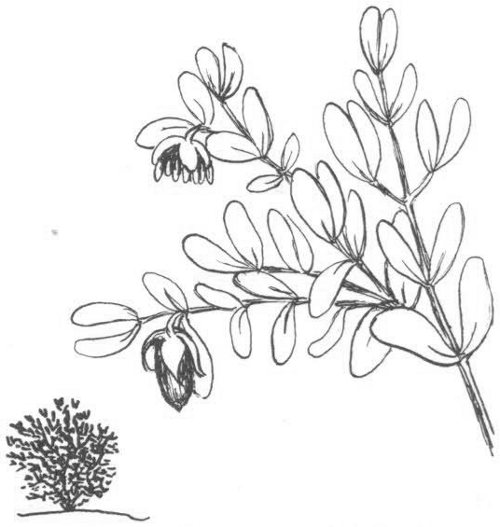
Jojoba leaves and fruit
13 SAGUARO. These magnificent giants are indicator plants of the Sonoran Desert. Saguaros produce a beautiful white blossom which has been designated the Arizona State Flower. Its bright red fruit is edible.
Saguaros grow as high as 50 feet and more, and may live as long as 200 years. After a good rain, large saguaros may weigh several tons. Their roots are shallow—not more than three feet deep—which allows rapid absorption of ground-surface moisture. The pleated skin expands, accordion-like, as the inner pulp swells with absorbed water.
The Gila woodpecker is responsible for many of the holes you see riddling mature saguaros; the bird will excavate a half-dozen or more potential nests every year. Other birds use the woodpecker holes, particularly the elf owl, a six-inch midget which can live only where the saguaro and the woodpecker provide it with a home.
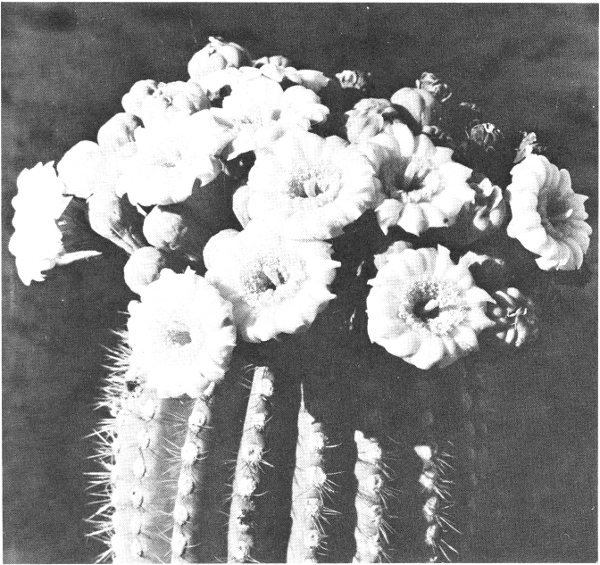
Saguaro blossoms.
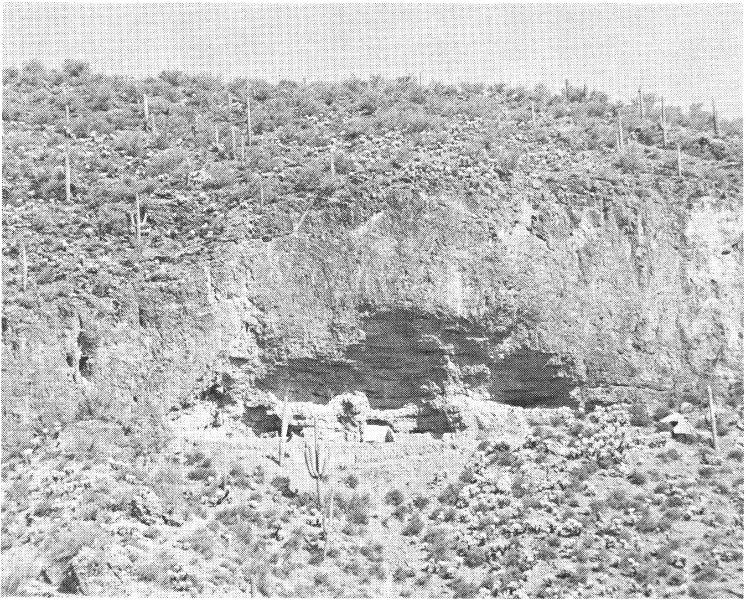
The Annex.
14 THE ANNEX. Look above you, at the base of the cliff; do you see a five-foot manmade wall? Once there was a Salado village in the shallow recess above; it was contemporary with the Lower Ruin just around the corner and probably housed its population overflow. There were about a dozen rooms in the Annex, traceable from tiny fragments of walls and plaster room outlines. Because the recess is so shallow and offers little shelter, the Annex was destroyed by weather long ago. What you see from the trail here is all there is to see.
15 TEDDYBEAR CHOLLA. Imagine the misery this cactus gave the scantily-clad Salados as they moved about gathering wild food and hunting deer and other creatures. The teddybear’s joints break off very easily and stick to a victim at the slightest contact, even seeming to jump at a victim, hence its other name, “jumping cactus.” Cholla 8 spines penetrate deeply and are very painful to remove; remember—people who stay on the trail stay out of the way of the cholla. The noisy cactus wren somehow makes use of the teddybear as a nesting site, and the woodrat drags cholla joints home with which to barricade his burrow.
16 CEMENTED ROCK. This rock broke away from the cliff above and rolled here. The diagram explains the geology; broken, faulted Dripping Spring Formation rocks, here mostly quartzites, were overlain by a layer of limestone; water percolating through the limestone dissolved materials which then seeped down through the fragmented rocks and, drying, cemented the broken bits together, as in the boulder here.
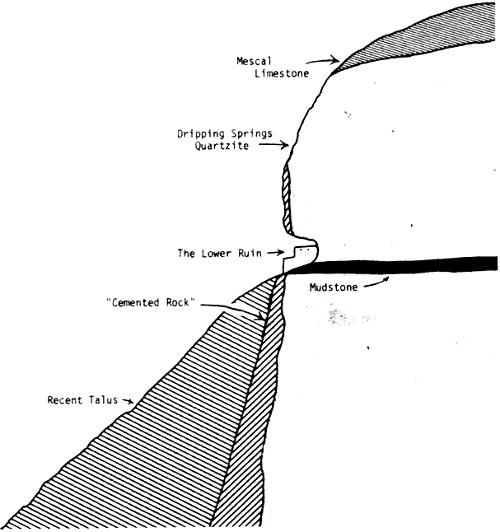
Sketch of Geological Cross-section.
Showing: Mescal Limestone, Dripping Springs Quartzite, The Lower Ruin, Mudstone, “Cemented Rock”, Recent Talus
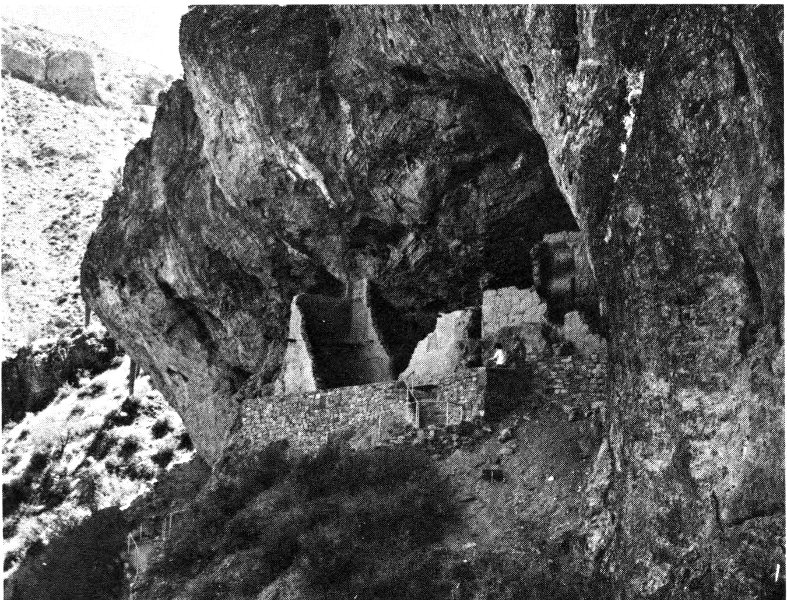
Overhanging roof of natural cave preserved the ruin.
17 FORMATION OF THE CAVE. Under the shattered quartzite was a layer of soft mudstone. Rain and seepage dissolved the mudstone, removing support below the 9 quartzite, which then fell away from the cliff. Gradually this natural erosion enlarged the cave you see today. When the Salado came seeking a protected place to live they found a natural cave some 50 feet deep, 40 feet high, and 85 feet long, littered with all the building stone they needed.
18 BASEMENT ROOMS. Outside and below the cave were 3 or 4 “basement” rooms, probably houses identical to those in the cave and the Annex. The cave village itself contained about 20 rooms originally, the exact number uncertain because rooms toward the front of the dwelling have weathered away. With the Annex, basement rooms and cave village counted together, there were about 40 rooms (houses) in this immediate area. While population estimates are difficult to make with accuracy, probably between 40 and 60 people lived here long ago.
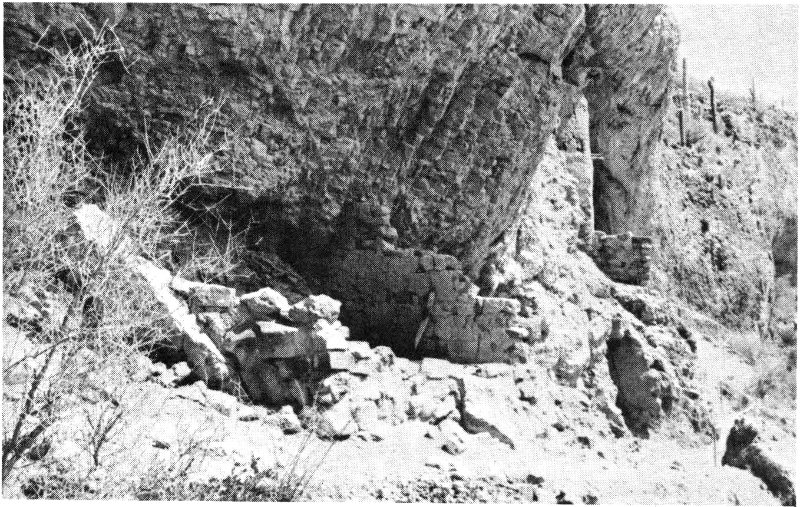
Fragmentary walls of the “basement” rooms.
19 THE ORIGINAL ENTRY. Above you is a V-shaped notch which was probably the only original entrance to the village. A ladder from the roof of a basement room led to the passage above, where projecting rocks are polished from 10 long use as handholds and footrests. When the Indians wanted to close the village door, they simply pulled up the ladder.
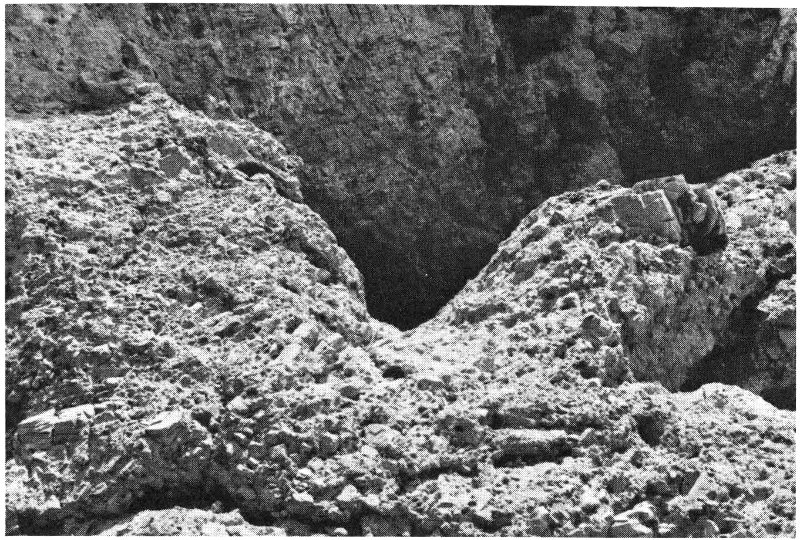
The notch which was the original entry.
Salado children who scrambled in and out of this entryway knew the dangers of these loose rocky slopes, but our children are much less aware of the slope’s hazards. For your children’s safety, please keep them with you. Leaving the trail or running on it invites injury.
As you go up the modern stairs, note the retaining wall; it is probably closely similar to the original wall. The village once extended out as far as the retaining wall, rooms dividing what is now open space at the front of the cave, but the original rooms and wall have eroded away.
20 THE ANCIENT SCENE. Think back 700 years and imagine this view then; no power lines, no roads, no lake, no smog. This spectacular view of the Salt River Valley provided a fine defensive outlook. We do not know who—or 11 what—drove the Salado to the high places, but this village and others like it seem to have been built for defense. Little evidence of warfare has been found.
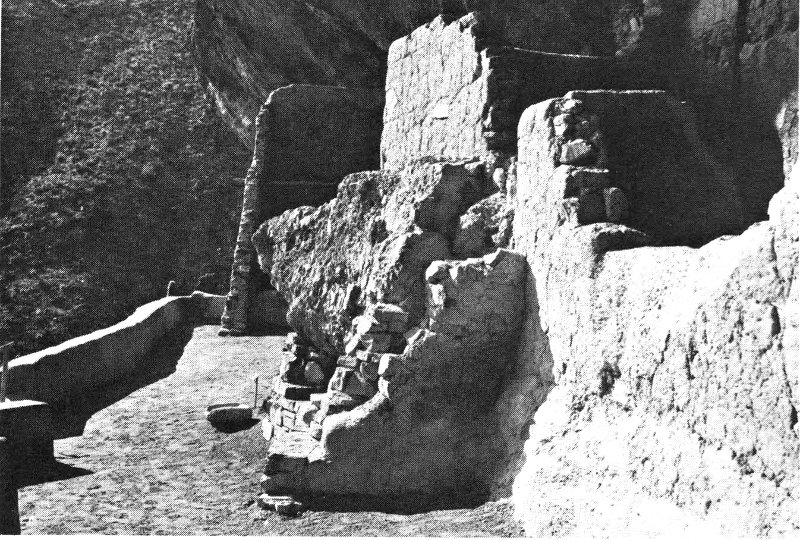
Once four or five rooms were here in the front of the cave; erosion has destroyed all but the wall stubs you see on the right.
Because the ruin is easily visible from the valley it was quickly discovered, probably by ranchers in the 1870s. The first written record of the Tonto ruins appeared in 1883, by which time they were well known.
The cliff dwelling overlooks the valley where Salado farms were tilled—1,000 feet below the village here, and 2 to 5 miles away. Ancient irrigation canals which watered Salado corn could still be seen until Roosevelt Lake flooded the valley after 1911. To walk 5 miles or more to tend a crop was not unusual for a Pueblo farmer. Well into this century Hopi Indians, distant modern relatives of the ancient Salado, ran as far as 20 miles to their cornfields.
21 TWO-STORY ROOM. The west wall of this two-story room is one of the few that reached to the cave ceiling. The 3 beams mark the ceiling of the room’s first floor, and 2 beam sockets higher up indicate the second floor ceiling. Most rooms had a 3-foot-high parapet wall around the roof, providing a safe place in the open air for work or play.
The small hole in the second floor wall overlooks the original entryway, reminding us that this was probably a fortified village built during troubled times.
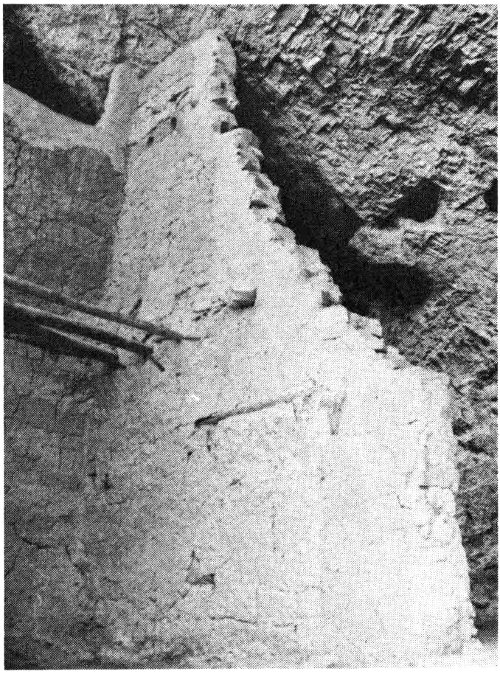
Two-story room (note sealed doorway in first floor)
22 THE ENTRY HALL. If you stood here long ago, you might see a man bringing home harvested corn, or game of some sort. Women might be lugging heavy water jars up from the spring in the canyon. Small children would play about your feet while their older sisters and brothers solemnly imitated adult work.
The little unroofed room to your right is a fine example of the way the Salado used the natural cave: here they simply built a curved wall across a natural recess, creating a small unroofed room which was apparently used for cooking, judging from the smoke-blackened walls and the several firepits once found here.
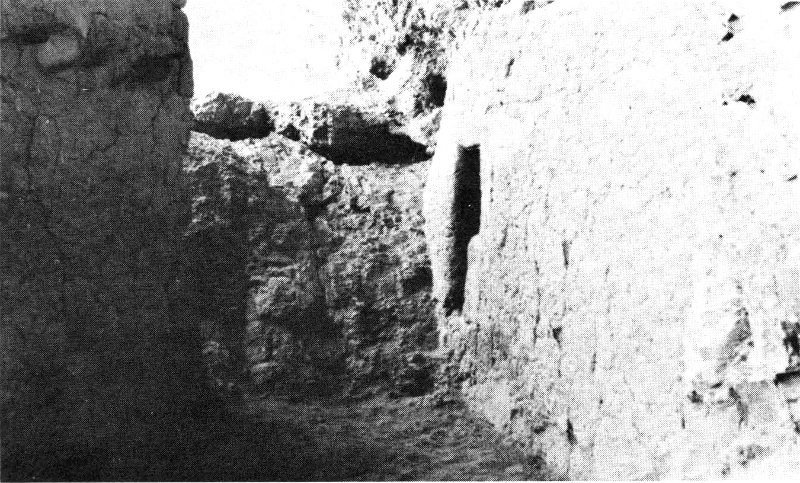
The entry passage.
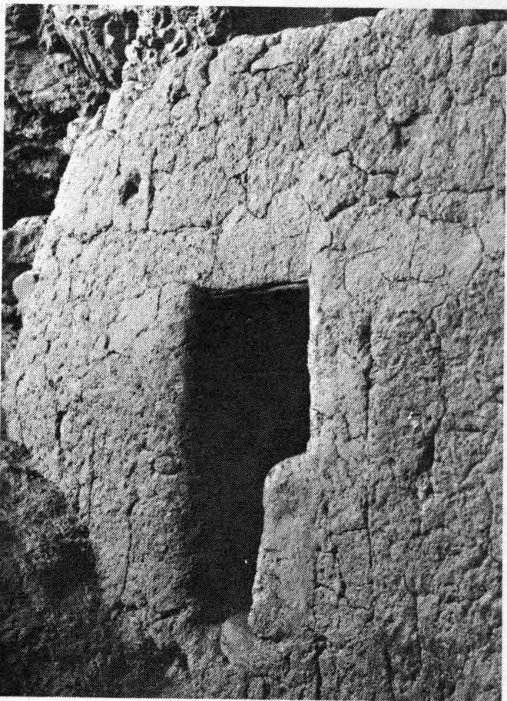
Room with half-T door.
These people made many of their doorways in the half-T shape you see in this little room. The half-T prevented strong drafts, and provided a place to balance with one hand while stooping through the door. Salado men averaged about 5 feet 6 inches tall, the women about 5 feet, so they had as much difficulty as we do getting through these small doorways.
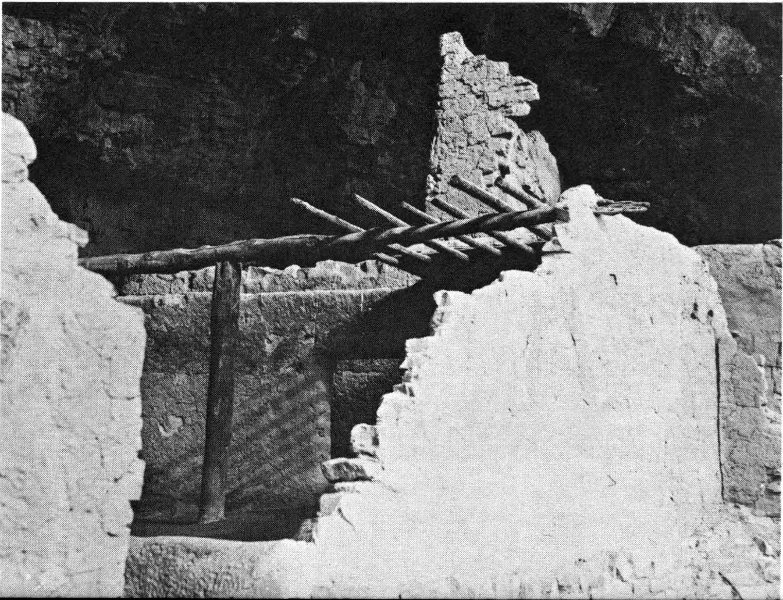
Original roofing timbers remain in portions of Lower Ruin.
23 PARTIAL ROOF. This large room contains a good example of Salado roofing technique. Walls of stone and mud were built in courses about 2 feet high each, until they reached 6 feet in height. A central upright post was then placed to hold a main roof beam. The smaller roof poles rested on the main beam, and above them went a layer of reeds, saguaro ribs, grass or other small poles. On top of these layers went a thick mud coat, deep enough to allow a shallow firepit to be safely built in the upstairs floor.
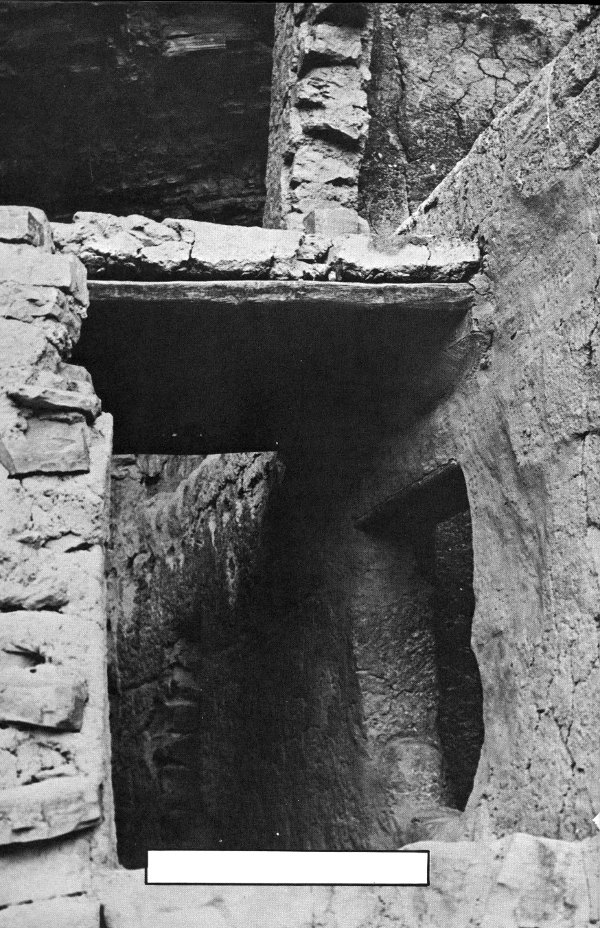
Hallway with partial mud-capped roof.
24 HALLWAY. The village was not built all at once. Construction at different times is revealed in sealed doorways, wall abutments, and hallways. This passageway gave access to three rows of ground floor rooms; it probably also served as additional storage space.
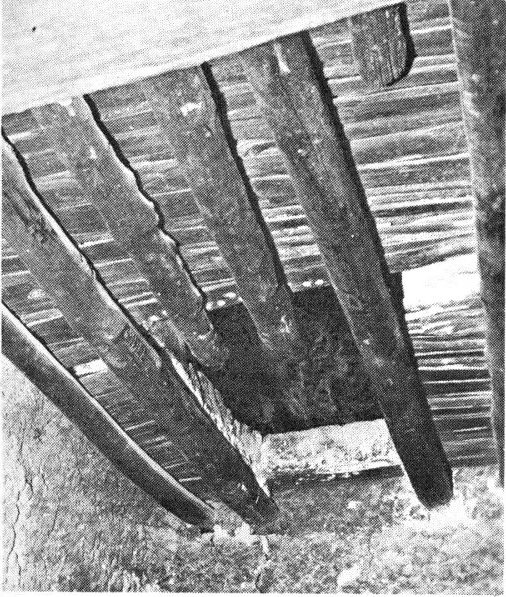
Interior roofing and hatchway to room above.
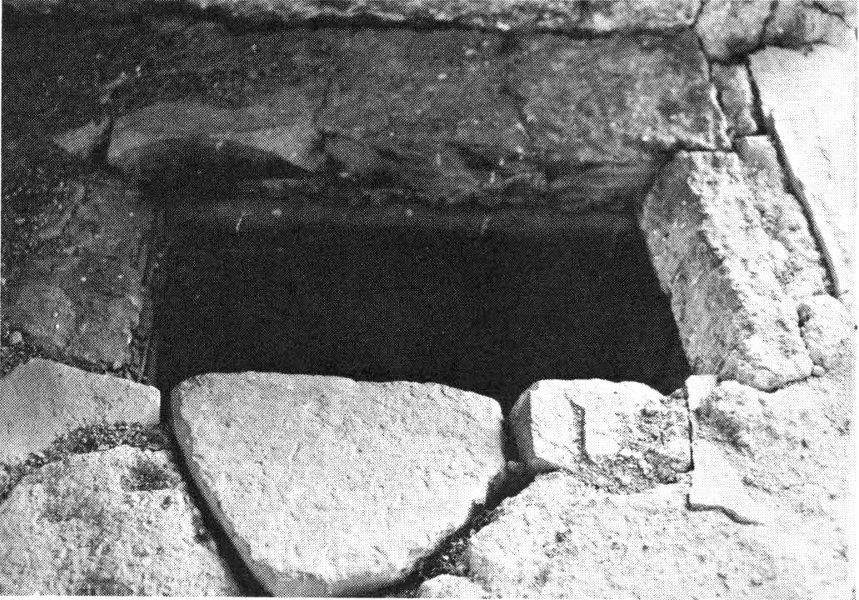
Stone-lined hatchway.
25 ORIGINAL ROOM. Look inside and imagine how dark and stuffy these rooms were. Often ground-floor rooms in the back of the cave—dark and poorly ventilated—were used just for storage. Ladders gave access to different floor levels in the village, sometimes through corner hatchways like the one in this room.
26 ROOM USES. During excavation of this village, an infant burial was found in the corner of this room. The death rate among infants was high, and burying babies in the corners of houses was the custom among Pueblo Indians until quite recent times. Adults were usually buried in the loose rock slope in front of the village or in abandoned 16 rooms. Terraces in front of some cliff dwellings served as burial grounds, but no terrace or cemetery has been found here.
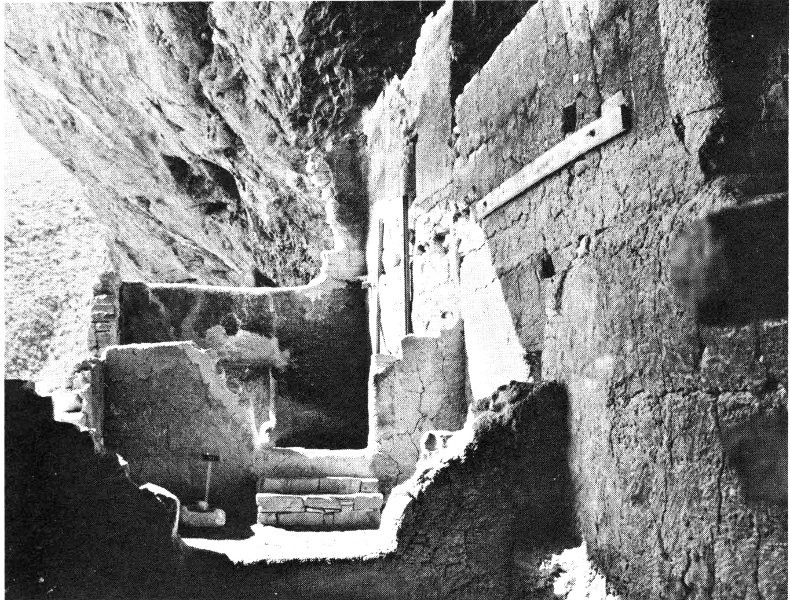
Connecting rooms in two-story section of ruin; burial was found in right-hand corner of farthest room.
Although these rooms are small by our standards, there was no need among the Salado for larger spaces; actually the Salado houses are remarkably large in comparison to most cliff dwellings. Since the climate is mild here, most of the Indians’ time was spent on the roofs and outdoors. Houses served mainly for sleeping, storage, cooking, and winter shelter. Salado furniture was minimal: a few pottery vessels, baskets, spare tools, a metate and firepit, mats for sleeping and sitting, perhaps a ladder to an upstairs room. Looms for weaving their elaborate cotton textiles were apparently outdoors, as no trace of them was found in the rooms.
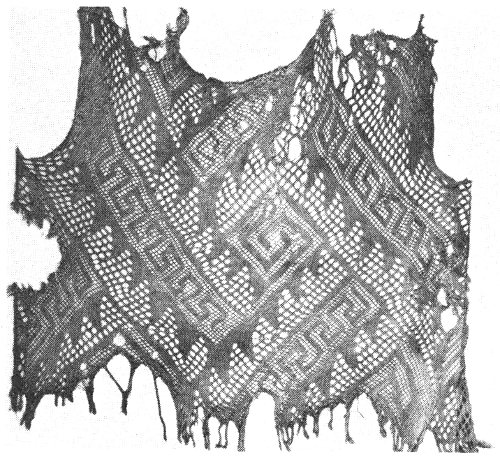
Elaborate woven cotton shirt recovered from Tonto Ruin—fine example of Salado weaving.
Photo courtesy of Arizona State Museum
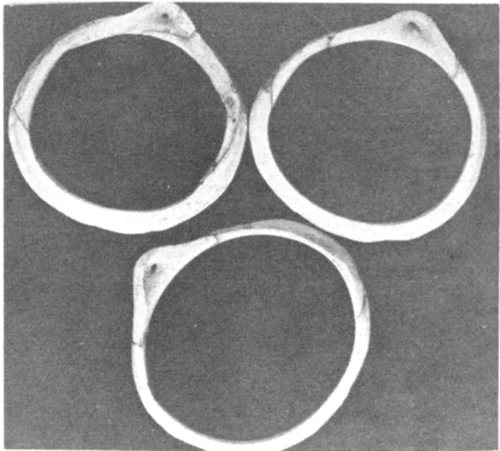
Shells traded from the Gulf of California were carved to make bracelets.
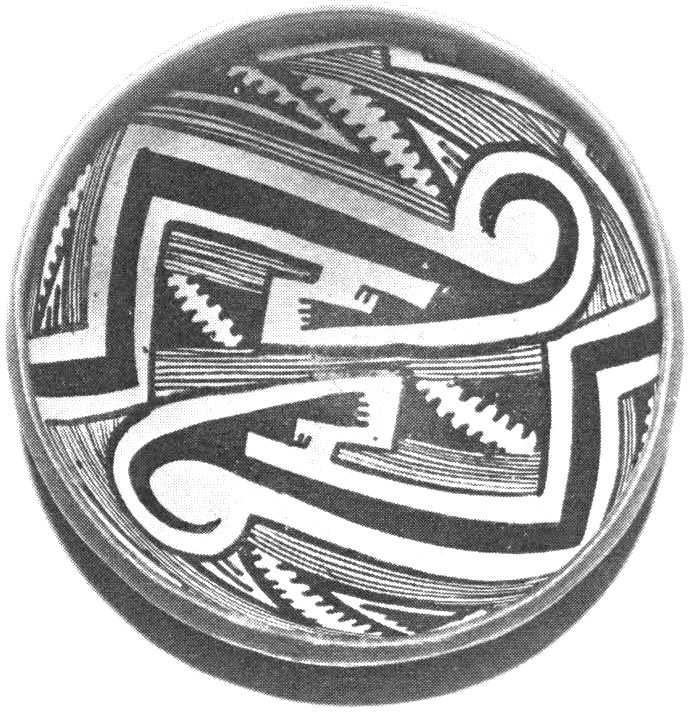
Dramatic geometric designs in black, white and red were characteristic of Salado pottery.
27 ORIGINAL CLAY FLOOR. All floors in the village were once smooth, made of adobe clay like this one, but heavy traffic over recent years has destroyed all but this one remnant. Please help us preserve this floor by staying out of the room.
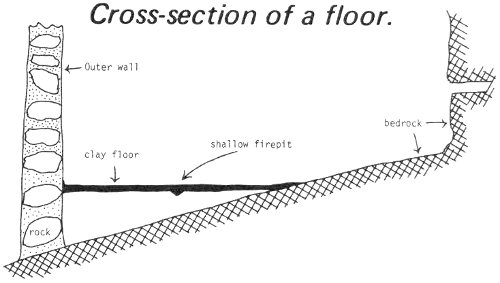
Cross-Section of a floor.
Showing: outer wall; rock; clay floor; shallow firepit; bedrock
At the back of the room the clay floor joins natural bedrock of the cave. Because the cave floor was so irregular, the 18 Indians had to build retaining walls and fill to make a level spot for their homes. Wet clay was spread on the fill to make, when dry, a smooth, level floor.
Note the little clay-lined firepit in the center of the room; it is only about 6 inches deep and 5 across, but provided adequate heat and cooking space.
28 METATE (meh-TAH-tay) and MANO (MAH-no). These Spanish words refer to the stone tools used for grinding dried corn, seeds, mesquite pods, palo verde beans and other foodstuffs. The small, hand-held stone is the mano. We do not know what the Salado called these essential kitchen tools, for their lost language was unwritten.
Imagine the many hours of hard work represented by the deep grooves worn in this hard stone! Try it yourself: kneel and rub the mano back and forth over the trough of the metate; think of doing such work for many hours each day.
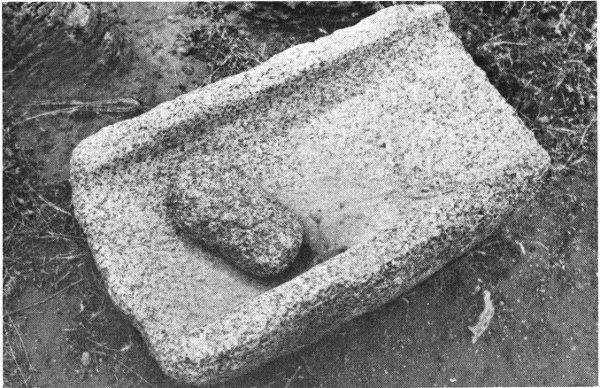
Metate and mano.
Can you see the broken metate that was used as a building stone? Look above the barred door to the right, just below the stabilizing beam.
29 SMOKE-BLACKENED WALL. Just as we do spring cleaning, Salado women frequently replastered their little houses with clay. Smoke from cooking and heating fires blackened the wall, but you can still see here hundreds of finger marks left as wet clay was smoothed by hand on the wall.
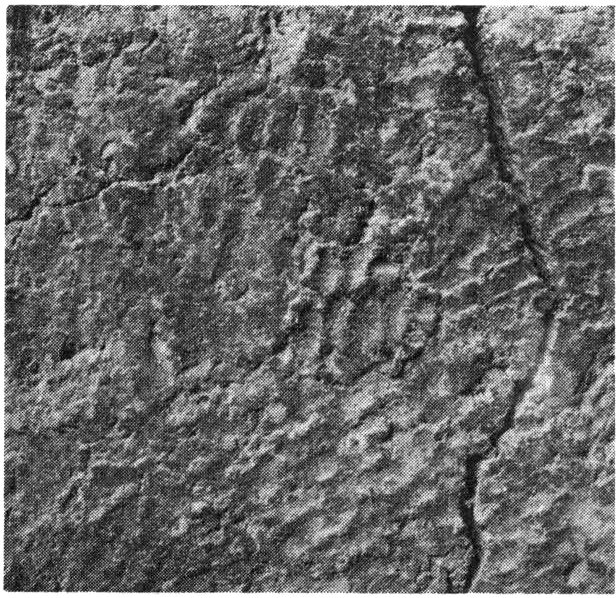
Finger imprints in plaster.
30 OPEN ROOM. The Indians did not build a roof for this room, because the cave ceiling served the same purpose. Since this large room had good light and ventilation, and offered space protected from the fierce summer sun, it was probably used as a community work area. Two seed grinders, called mortars, are worn into the bench-like bedrock in the back.
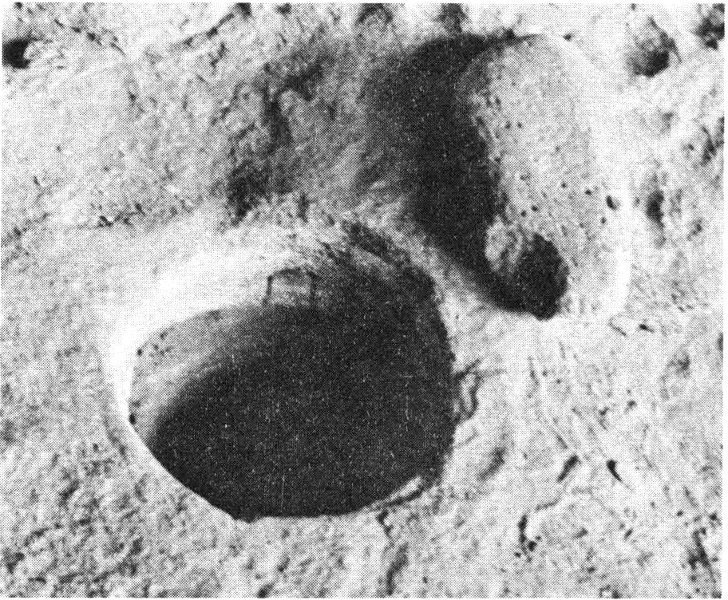
A bedrock mortar in the community workroom.
Any of the larger rooms in this village could have been used as meeting rooms or ceremonial chambers, but after damage by early souvenir hunters, no evidence of such use could be found during scientific excavation of the village. Another ruin in the area had a large rectangular room with an altar and other features indicating ceremonial use. Pueblo Indian religion today is deeply threaded through all phases of daily life, and these ancient Pueblos were undoubtedly equally religious.
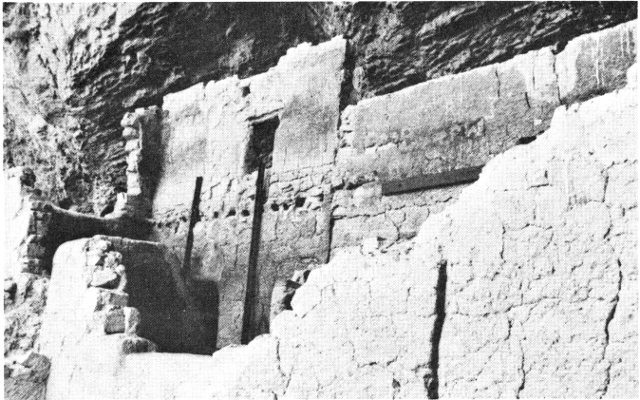
A view of the central section of the Lower Ruin
PLEASE BE CAREFUL
RETURNING TO THE PARKING AREA.
A thousand years ago the Salado first arrived in this basin, coming here around A.D. 900 from the region north of the Little Colorado River drainage. Though we do not know what they called themselves, it is here where later they were given their modern name. In Spanish, Salado means salty, referring to the Salt River near which these Indians lived.
When the Salado first entered the Roosevelt Basin they lived in the lowlands, along the Salt River floodplain where they could easily irrigate their fields. Though the area may seem inhospitable, the river’s flow is reliable—and water is an extremely precious resource in the arid Southwest. The great range of elevation nearby provides several life zones of various plants and animals to be utilized for richer living. Ponderosa pine forests and juniper-pinyon pine woodland both occur within 15 miles of this site.
The Salado enjoyed several centuries of comfortable life, with time for production of elaborately decorated pottery and ornaments, beautifully woven and embroidered cotton textiles, and, no doubt, development of elaborate religious thought and ritual.
But at about A.D. 1200, times changed and life became more difficult. Perhaps the population outgrew its resources. Perhaps disease spread. Perhaps some outside enemy pressure was felt. The reason remains unknown, but in the early 13th century the Indians began moving their villages to high ridges and ultimately to caves, finding defensible protected sites with good, sweeping views.
Unsettled conditions persisted, and finally life here, for reasons we do not know today, became impossible. Where they went, why they left, and what their ultimate fate was, we do not know, but by the early 1400s the Salado people were gone from the Salt River Valley.
PUBLISHED IN COOPERATION WITH THE NATIONAL PARK SERVICE BY
SOUTHWEST PARKS AND MONUMENTS ASSOCIATION
POST OFFICE BOX 1562
GLOBE, ARIZONA 85501
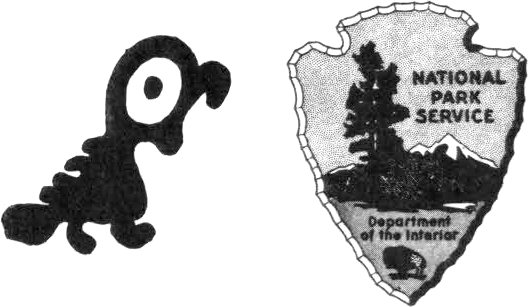
11th Ed. (Revised)
1974 20M
